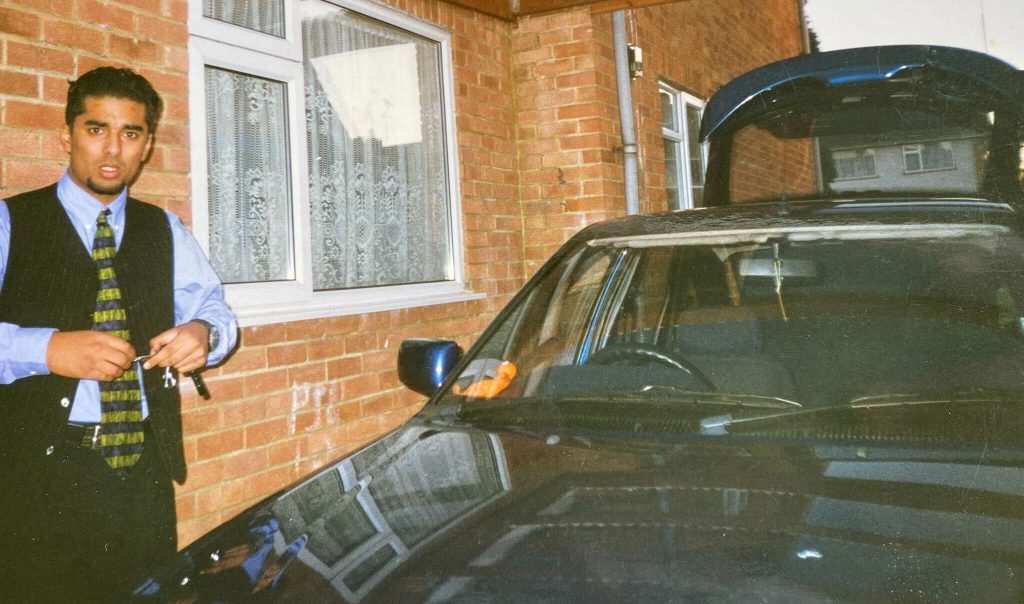If you’re anything like me, when you want something badly enough, the focus and determination needed just seem to fall into place.
As a 20-something-year-old, passing my driving test was one such goal; everything just happened from the moment I decided I was going to drive and nothing else mattered. I passed within 3 months. On the flip side, I have been intending to get back into the gym for 3 years, but haven’t quite mustered up the same level of motivation.
Clearly, desire alone isn’t enough. When I passed my driving test, my Formula 1 hero was Michael Schumacher, and whenever behind the wheel of my 1994 Ford Escort, I imagined myself in pole position and toasting a win from the top step of the winner’s podium. But the reason Schumacher set, and Hamilton have since broken records for the most wins, pole positions and podium finishes is because they are just one part of a high-performance, mission-oriented team.

Young Vindy and his Ford Escort
And this isn’t something exclusive to the world of motor racing. High-performing teams that deliver extraordinary results are critical to business success too. Motivation, direction, capability, and action are the essential ingredients you need for your teams to drive great outcomes.
Let’s go through these ingredients one by one:
Motivation
For over a hundred years, organisations have been characterised by their hierarchy and power structures. Work was dictated from the top and driven accordingly from the bottom. Leaders did the thinking and workers did the doing. This model is no longer fit for purpose, and 7 in 10 employees now demand more meaningful purpose from their job.
Many organisations are failing to recognise this and move beyond meeting extrinsic motivational needs such as more money, employee perks, or a ping pong table in the office. By addressing intrinsic motivators, like empowering people to be more creative and reach their full potential, the business impact could be significant: 81% reduction in absenteeism and 23% increase in profitability.
Focusing on both extrinsic and intrinsic motivation, mission-oriented delivery engages your employees so every role is meaningful. Whether you’re Lewis in the driving seat, or a trackside fluid engineer called Stephanie, you’re working for the same goal and need each other to be successful.

Direction
Change often fails the moment strategy crosses the boardroom threshold and is thrown into the organisation to execute. If the wider business isn’t involved in the creation process, an email stating, “Our goal is to become a digital business within 12 months,” won’t cut the mustard. Your employees are change-fatigued and likely to respond with ‘so what?’ (if they engage at all).
HBR summarises this downfall of strategic direction as a lack of communication, different altitudes, and low fidelity. As leaders, we need to distil the vision down to the level that individuals care about and can influence – showing how they fit into the bigger picture and how they contribute to strategic goals.
A mission-oriented team will pivot the focus from outputs to outcomes. They’ll organise around a complex and meaningful goal that contributes toward the strategic dials, and ask questions like, “What can we do in the next 90-days to accelerate time to market by 50%?”. They’ll find the best solution available to meet that outcome, not maximise the output from a solution they have been directed to.
This approach will also enable people to better understand their personal contribution, encouraging them to take greater ownership – and the research shows a clear correlation between employees, purpose, and profitability.

Capabilities
Consider that the current record for the fastest F1 pitstop is 1.82 seconds. In less than two seconds, 20 people come together in perfect synchrony to perform everything from changing the tyres, refuelling, swapping the steering wheel, replacing the wing, and performing safety checks on a vehicle worth approx. £16m. It’s perfectly executed because every person in that pitstop brings skills and capabilities to execute a specific action, which delivers a (seemingly impossible) shared outcome.
One of the biggest problems many organisations face is siloed ways of working. They are still designed and structured around functions – IT, operations, sales, marketing, HR and finance. The products and services our customers demand increasingly require these functions to come together for integrated outcomes, however, this creates friction, conflicts with reporting lines, unnecessary handoffs, bottlenecks, and incongruent ways of working – the average team uses 6 approaches to support project collaboration and at least 4 different communication tools.
Mission-oriented teams are both empowered and enabled to go after outcomes in a way that works for them and makes the best use of their combined capabilities. They are encouraged to set their own OKRs, define ways of working that align to their capabilities and needs, and are coached on how to leverage an array of practices and tools to achieve their objectives. What emerges are patterns of delivery and ways of working that align to the team and organisational context, captured in a blueprint that can be used to scale this capability across the organisation.

Action
No matter which organisation I work with, there doesn’t appear to be a shortage of work that needs to be done. In fact, many have more demand than the supply can meet. Burnout rates are increasing and the pace of value being delivered is decreasing. Many of our people are ‘busy’ – but how much of that is an effort to just manage the work? We’ve all sat in a meeting that could have been an email, or worked on a presentation because someone wanted an update on progress. The Anatomy of Work Index estimates that managers lose nearly two-thirds (62%) of their day to ‘work about work’. Just because we are busy, doesn’t mean we are moving the needle on the things that actually matter.
Action must be smart, and teams need to be empowered and enabled to make smart decisions about their work by leaders. As much as possible, they also need to be protected from the dysfunctions of the organisation. It is the essence of true servant leadership but can be challenging for those unaccustomed to this style. It requires leaders to create psychological safety for people to think, experiment, make decisions, and act without distraction or fear of reprisal. The leader is there to set the direction and spell out ‘what’ needs doing and ‘why’, but it’s for the team to decide ‘how’ they go about doing so. The leader must remove obstacles that stand in their way, provide the resources needed, and connect the dots with other parts of the organisation to help the team achieve the mission.

How to get started with your own mission-oriented team
We live in a world of unprecedented uncertainty across the political, technological, economic, and environmental landscape. What we’ve always done is no longer working. Leaders must help build organisational muscle to enable their businesses to become resilient to uncertainty and responsive to opportunity. This needs to be built from the bottom up with top-down direction and enablement. A mission-oriented approach offers a scalable and sustainable way to do this. But, it takes a courageous leader to stand up and champion this way of working.
You must first accept that you need to try something different. When I work with organisations that have reached this point, we often take a step back and look at the strategic vision they are trying to achieve. We work backwards mapping the goals and objectives that they have set for that vision to be realised, and then look at how their current portfolio of work aligns to this. Very often this is where disconnect and duplication start to emerge.

Next, we prioritise based on value and complexity, not who is shouting the loudest or is the most important person in the room. We ask questions like:
- What work delivers the most important and valuable outcomes?
- What enables greater value to be unlocked later?
- What are you avoiding because it is too complex?
Finally, when we have identified the ‘what’, and there is a clear line of sight to the ‘why’ (the strategic outcomes and vision), you must define a mission and mobilise a team to figure out the ‘how’. You also need to establish the support mechanisms, coaching, and leadership that will enable and guide that team through a journey of discovery, solutioning, and the iterative execution of their mission.
As a courageous leader driving this way of working, you may initially feel that you are standing alone amongst your peers. Your actions might be perceived as non-conventional and counter to the prevailing culture, but somebody needs to light the fuse and create a catalyst for change. If not you, who? And if not now, when?
If you need help establishing your own mission-oriented team, get in touch…





































































